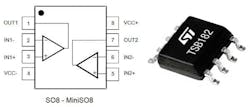Automotive-Rated Dual Op Amp Blends Medium Voltage and Accuracy
This article is part of the TechXchange: Exploring Op Amps.
Given the literally thousands of op amps already in vendor standard-product catalogs, it’s easy to think there’s really no need for any more of them. Yet every year, tens if not hundreds of new versions of these basic analog building blocks are introduced.
Why? Because every op amp—as with most components—is a blend of various performance attributes and tradeoffs. Some are pretty good in almost all of their specifications yet not really outstanding in any individual one (and that’s okay), while others may excel in one or two key parameters but be “only” fairly good in the others. Designers must look at their priorities and corresponding tradeoffs to select the one that works in their applications.
The TSB182 dual op amp developed by ST Microelectronics is an example of a blend, as it combines the two usually disparate attributes of medium-voltage operation and precision performance. Further, it does so in a MiniSO-8 package (approximately 3 × 3 mm), which saves board space and enables smaller module sizes (see figure).
With an operating-voltage range of 4 to 36 V, it targets high-accuracy automotive and industrial signal conditioning with sensors, featuring maximum input offset voltage of 30 µV over the full temperature range (20 µV @ 25°C) and 100 nV/°C drift over temperature.
The TSB182 also combines fast dynamic response and low power consumption, with typical operating current of just 650 μA per amplifier. The gain-bandwidth product (GBW) is 3 MHz, with slew rate of 2 V/µs, ensuring minimal output distortion across the frequency range. The input noise voltage of 24 nV/√Hz supports applications that demand high resolution along with front-end signal sensitivity.
In addition, the devices are hardened against electromagnetic interference for enhanced performance in electrically noisy environments, and they offer electrostatic-discharge tolerance of 4 kV HBM (human body model).
The TSB182 is supported by a 30-page datasheet with the requisite detailed tables, charts, and graphs needed by precision analog-circuit designers and their models, characterizing all aspects of performance at both nominal and extended settings. It’s specified from −40 to 125°C, with AEC-Q100-qualified devices also available. The device, housed in a MiniSO-8 package, is priced at $0.96 (1,000 pieces); ST will add a standard SO-8 package option later in the year. Automotive-qualified device pricing begins at $1.15.
Read more articles in the TechXchange: Exploring Op Amps.
About the Author

Bill Schweber
Contributing Editor
Bill Schweber is an electronics engineer who has written three textbooks on electronic communications systems, as well as hundreds of technical articles, opinion columns, and product features. In past roles, he worked as a technical website manager for multiple topic-specific sites for EE Times, as well as both the Executive Editor and Analog Editor at EDN.
At Analog Devices Inc., Bill was in marketing communications (public relations). As a result, he has been on both sides of the technical PR function, presenting company products, stories, and messages to the media and also as the recipient of these.
Prior to the MarCom role at Analog, Bill was associate editor of their respected technical journal and worked in their product marketing and applications engineering groups. Before those roles, he was at Instron Corp., doing hands-on analog- and power-circuit design and systems integration for materials-testing machine controls.
Bill has an MSEE (Univ. of Mass) and BSEE (Columbia Univ.), is a Registered Professional Engineer, and holds an Advanced Class amateur radio license. He has also planned, written, and presented online courses on a variety of engineering topics, including MOSFET basics, ADC selection, and driving LEDs.

